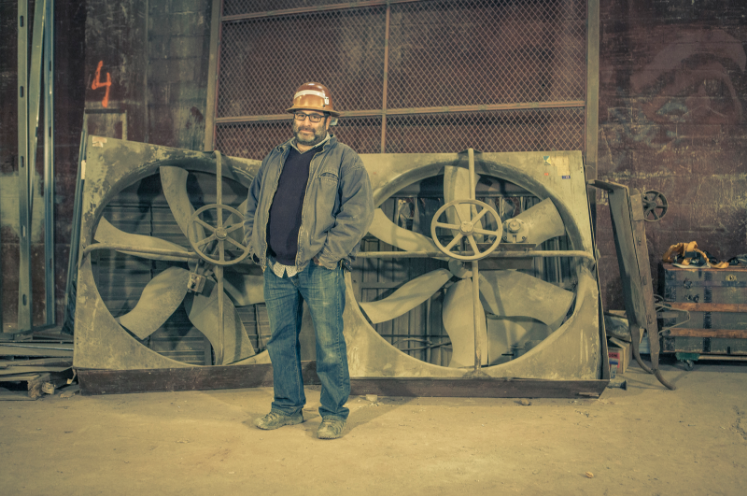The Bowery Presents, the New York concert company that quickly became one of the most powerful independent promoters in the country, introduced its latest venue, Brooklyn Steel, last month on April 6th, with five sold-out shows by the homegrown-in-Brooklyn LCD Soundsystem. We sat down with Scott Raved of The Bowery Presents to talk all things Brooklyn Steel—a former steel fabrication factory turned state-of-the-art music venue—and all the hard work that went into bringing such a project to life.
The Bowery Presents worked with HLW Architects to transform the active warehouse into Brooklyn's now largest general admission venue. Milrose had the pleasure of consulting on the project to bring the former steel factory up to today's building code as well as streamline the permit approval process to allow the venue to make its spectacular sold-out debut. Raved commented “We were unsure exactly what day we would be able to open, due to the down to the wire nature of the DOB paperwork. However, once it looked like we would have the paperwork in hand, [we] put the five nights of LCD on sale without any advance notice or build out… it sold out within minutes.”
Raved has been involved with the likes of The Bowery Presents for eight years. His background in construction management and general contracting prepared him well for the impending madness attached to opening a space like Brooklyn Steel, which features a 10,000 square-foot green roof, moving production stage, horseshoe mezzanine, three bars, raised platforms throughout, and lots and lots of steel accents.
Located at 319 Frost Street, the 20,000 square-foot venue has a 1,800-person capacity. The venue's principals, Jim Glancy and John Moore, decided on this spot for very specific reasons. The Bowery also presents at the Williamsburg Music Hall, a 700-person venue, and “we had been looking for a larger property in Brooklyn for almost four and a half years. It turned out that our landlords at Williamsburg Music Hall owned the Brooklyn Steel building. Jim had never been to their office before and he happened to stop by to drop off checks after a morning of looking at warehouses and having another fruitless search. He walked into the space and saw a 62 by 200 ft. clear span and realized it was a no brainer to try to make the building work for us.” All good things come at a price, though. So what was the difficult part of getting this space? “Convincing the community board that we would be good for them.”
During our time talking with Raved, it became clear that a huge part of this project was contingent on the community surrounding it. The project differed from those Raved has headed in the past. “I had previously worked on Union Transfer [another venue for The Bowery Presents] which was similar in that it had a moving production stage, but on a smaller scale – we knew that that idea works well for us, so what we did here at Brooklyn Steel is just a lot bigger, and on a bigger scale. We try to learn from our experiences and keep doing better.” Not only did the project want to do better for itself, but it also desired to maintain an improved relationship with its surroundings. Being a good neighbor was paramount. “A huge part of this this scope was containment. The green roof and all of the containment scope was pretty extensive. I would say it was somewhat of a learning curve because we've had problems with noise at other venues so made sure to make containment a big part of the scope from the beginning.”
The green roof talked about here is exactly what it sounds like. Made up of different types of sedum, which can be compared to a succulent plant, it’s been an admired addition to the neighborhood among community members. And as for The Bowery Presents team, the green roof was the key to the containment. “It allowed us to go almost three feet higher than code allowed normally. Containment is just a ratio of air gap and mass, more of one and less of the other, so that air gap gave us the ability to have the green roof medium be an adequate amount of mass, whereas if we just wanted to put decoupled mass right on top of the existing roof, it would have overloaded the existing truss, columns, and footings. It was a really good solution to our problem.”
The Bowery Project was unique in more ways than one. Raved and his team decided to use the 2014 edition of The New York City Building Code. “Life safety is really important to us, so I didn't see any benefit in trying to hold onto an old code.” Raved went on, “one of the biggest constraints of the property was that we were completely maxed out on the F.A.R. Milrose provided us with a lot of help finding creative ways to get the square footage to build the mezzanine – for example, by holding onto the parking spaces of the courtyard and other offsetable areas like the loading bay and the mechanical spaces.” Milrose also helped the project attain extra floor area through obtaining bonuses and deductions through zoning code regulations. For example, the code allows you to deduct spaces that are not usually occupied by individuals (like mechanical spaces or open stairwells) from your total floor area, which allows you to expand your footprint in other areas. This allowed Bowery to build what they’d envisioned originally; they were able to take full advantage of the floor area, both on the first level and on the mezzanine level.
The Brooklyn Steel project had multiple code issues to address throughout the design and construction process. Barrier free compliance was essential to the overall site and to all public spaces in the building. The former industrial building was transformed into a fully accessible venue to accommodate patrons with various disabilities. From a fire safety standpoint, no stone was left unturned. The ability to safely and quickly evacuate 1800 people in the event of an incident was carefully planned. The building has surplus exit capacity and multiple active/passive fire protection systems to assure that all life safety conditions are met. Use of the new code also ensures that the building is structurally sound and will tolerate whatever conditions mother nature can dish out.
And of course, we can’t forget about the moving stage. A performance platform “built for rock and roll,” as Raved excitedly told us, “it is four-inch thick concrete, and serviced by one of the greatest sound systems in the world. It is a pretty formidable production - the bands that have come through looking at it have felt that the stage and the room were really made for rock and roll.” But with all the bells and whistles that come with a new, sparkly building, those pesky compliance codes still play a part. Meeting compliance for the 2014 energy code was tough, Raved explained. It was frustrating for the team as the 2014 energy code is extremely difficult to comply with - particularly when masonry structure or glass of masonry is involved. But meeting the 2014 energy code compliance was something they were committed to. Milrose assisted in bringing the former steel factory up to today's building code and streamlined the permit approval process in order to allow the venue to make its spectacular debut to the public earlier this month.
When we spoke to him, Raved’s pride for the project was clear. “Every one of these venues is just a treat to work on. For me, the coordination isn't any less for these venues, but the use is just so different. Just to see the doors open up as people come in and every night—it's different sold out crowd for a different band—it's great to see the venue come alive. It was a pleasure working with Milrose for this project, and we look forward to the next one.”
Photo Credit: Gregg Greenwood








